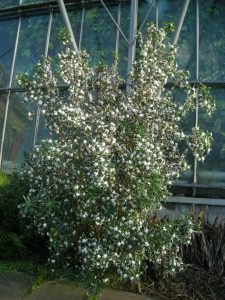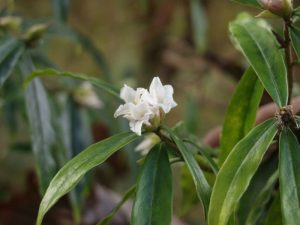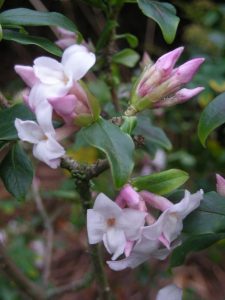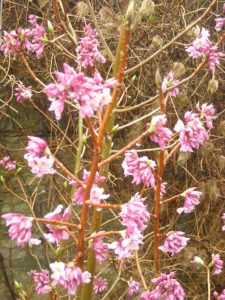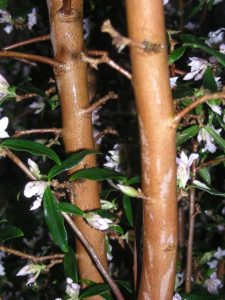Various forms of Daphne bholua are planted throughout the Garden. The earliest to flower is towering up 5 metres from the sheltered courtyard to the north of the Glasshouses Front Range. Carefully lean over the railings and breathe in the heavy scent exuding from this plant. The flower clusters terminate last year’s growth, a light violet in bud, opening white.
This plant is native to the Eastern Himalayan mountain range and is found as an understory plant beneath Tsuga dumosa forest, with evergreen Magnolia and Quercus sp. The image shows a plant with white flowers in November on the road from Dochula, Bhutan at c.2900m where views to the snow capped summits of the Himalayan peaks border Tibet. As with cultivated specimens, the evergreen leaves have a chlorotic appearance to the edges which are prone to curl in on themselves.
The flower colour within the species is variable and the plant growing to the west of the Orchids & Cycads glasshouse is very lightly shaded pink in bud. From a distance, the overall appearance is of a mass of white bloom. This plant is one of the seedlings collected at an altitude of c.3000m by Peter Smithers on the Daman Ridge, Nepal.
Another collection from Eastern Nepal, growing at a slightly higher elevation c.3200m, was made by Spring-Smyth, who was an officer in the Gurkha regiment. His find was given the cultivar name ‘Gurkha’. Differing from the evergreen type species this cultivar flowers on deciduous wood. ‘Gurkha’ has fusty purple pointed buds. These elongate and emerge from a sheath of sepals as terminal clusters on the previous year’s growth. This growth is highly polished wood pitted by leaf scars. A good specimen grows in the south-facing border adjacent to the Alpine House. Again, as if to prove the variation within the species, this has an overall deep pink appearance and an upright form of growth.
Avoid standing or walking on cultivated soil when appreciating these plants. Constant foot traffic over cultivated areas will result in compaction and loss of pore space in the root zone resulting in a reduction in vigour of the plants.

